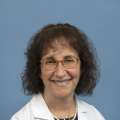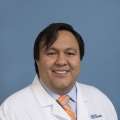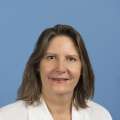When Nasser S. El-Okdi, MD, is not caring for patients in the ICUs of UCLA Health’s Westwood and Santa Monica hospitals, he often is looking after patients of a different sort in the makeshift “ICUs” constructed of Ikea storage units he has set up in his home.
There, he devotes his time to healing a dozen or so of the more than 100 sweetly scented hoya plants that he cultivates, tending to such flora-threatening issues as root rot and soil imbalances. It is a comforting reminder of his childhood in the beautiful but battle-scarred Bekaa Valley of Lebanon.
“My mother had this beautiful plant grown from cuttings someone had given her before I was born,” he recalls. “My family had found a spent tank shell in the mountains, and she turned it into a planter in which she grew a hoya plant.”
Dr. El-Okdi’s hoya hobby began many years after he came to the United States. During the pandemic lockdown, his then-roommate was watching a video that featured the plant. “I had always had plants, but not the hoya,” says Dr. El-Okdi, a UCLA Health hospitalist.
Now, the fragrant perfume of its star-shaped flowers centers him, brings him tranquility and returns his thoughts to his homeland thousands of miles away. And it helps him to allay emotionally jagged memories from his past — of upheavals and resettlement, family trauma and difficult assimilation in new homes.
“My mother loved this plant,” he says. “It blooms into these beautiful tendrils at night, filling a room with an aroma that makes me nostalgic.”
Dr. El-Okdi was born in 1985. In the years preceding and after his birth, Lebanon was wracked by civil war and conflict with Israel, it’s neighbor to the south. His father, a noncombatant, was seriously injured when he was shot during one of the many conflicts that raged on and off in the region. “He nearly died,” Dr. El-Okdi said.
His mother held an American passport, and when Dr. El-Okdi was 4 years old, the family left the violence and economic hardship they faced in Lebanon and resettled in Toledo, Ohio. “My struggle began when we moved to America,” Dr. El-Okdi says. “I had to quickly adapt to a new environment, culture and language.”
But the violence and tragedy did not stop once the family moved to the United States. Not long after Dr. El-Okdi turned 11 years old, his eldest sister — his role model who introduced him to the wonders of science — was abducted while driving home after a family visit, shot and left in an alley to die in the freezing cold of an Ohio winter.
“Her death plunged me into a new reality,” he says. “It was then, at that very young age, that I was confronted with the concepts of mortality and of fragility, not only of the human body but also of the mind, and its reaction to such unexpected events.”
He recalls how he began to analyze life and human behavior, and he thought about what might have been done medically to save his sister. “The answers I sought, coupled with the interest in physical and behavioral science she instilled, resulted in a keen interest in biology as I entered high school,” Dr. El-Okdi says. “Further events in my life would nurture and strengthen this newfound dream.”
One of his brothers-in-law, an internist, would take the young boy with him on rounds and encourage him to explore what Dr. El-Okdi calls “the artistic components of medicine, such as the psychological influence on disease and prognosis.”
Tragedy struck again during high school when a cousin in Lebanon was diagnosed with Hodgkin’s lymphoma. Her parents hid the truth and told her she had tuberculosis, but she became suspicious when she started to undergo chemotherapy. Dr. El-Okdi was visiting in Lebanon over the summer. He and his cousin were very close, and she turned to him for truthful answers. Going against her family’s traditional, superstitious belief that lying to her was the best thing to do, he agonized and then told her the truth. When she died, “her death once again caused me to reevaluate the meaning of my life,” Dr. El-Okdi says. “The growth of my dream was stunted because I felt that modern medicine had failed to provide a cure for her.”
After Dr. El-Okdi graduated from college, he felt he needed to reconnect with his family’s roots and returned to Lebanon, where he taught biology and chemistry to seventh, eighth and ninth graders at an Islamic school. When he returned to the United States, he focused on biomedical sciences in graduate school, and then earned his MD from the University of Toledo College of Medicine and completed residency training at Boston’s Beth Israel Hospital.
“I felt a need in my life to help others in a way that may have helped my cousin or my sister survive, a step forward in changing the face of medicine,” he says. He considered specializing in psychiatry, thinking it might help him deal with the trauma that had marked his youth, but turned, instead, to internal medicine.
“My research, the mentoring I received and the deaths of my sister and cousin make me realize that strength is a necessity for a doctor because physicians need to be strong when medicine fails,” Dr. El-Okdi says.
Now, breathing in the jasmine and cinnamon scents of the hoya blossoms helps him to sustain that strength, linking his past and present. Says Dr. El-Okdi, “My intertwining journey of cultivating both plants and human well-being is a reminder to me that in the art of healing — whether it is a patient in need or a humble hoya — the essence of care remains universal.”
Robin Keats is a freelance writer in Los Angeles.





